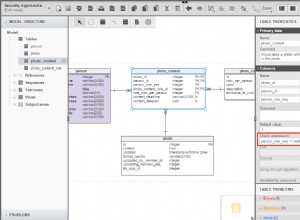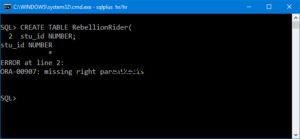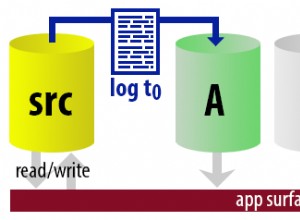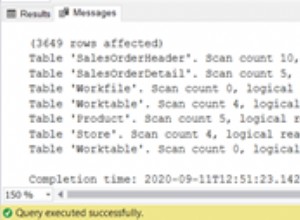Ändern Sie join items i ... um LEFT join items i ... und Ihre Abfrage sollte wie erwartet funktionieren.
BEARBEITEN
Sie können LEFT JOIN-Tabellen in der where-Klausel nicht filtern, es sei denn, Sie berücksichtigen Nullen, da die linke Verknüpfung zulässt, dass diese Spalten einen Wert haben oder null sind, wenn keine Zeilen übereinstimmen:
and i.siteid = 132 wirft alle Ihre Zeilen weg, die eine NULL-i.siteid haben , wo es keine gab. Verschieben Sie dies auf ON:
left join items i on ic.itemid = i.itemid and i.siteid = 132
oder machen Sie das WHERE-Handle zu NULLen:
WHERE ... AND (i.siteid = 132 OR i.siteid IS NULL)
BEARBEITEN basierend auf OP's edit 3
SET NOCOUNT ON
DECLARE @Categories table (CategoryID int,Title varchar(30))
INSERT @Categories VALUES (1,'Cat AAA')
INSERT @Categories VALUES (2,'Cat BBB')
INSERT @Categories VALUES (3,'Cat CCC')
DECLARE @SubCategories table (SubCategoryID int,CategoryID int,Title varchar(30))
INSERT @SubCategories VALUES (1,1,'SubCat AAA A')
INSERT @SubCategories VALUES (2,1,'SubCat AAA B')
INSERT @SubCategories VALUES (3,1,'SubCat AAA C')
INSERT @SubCategories VALUES (4,2,'SubCat BBB A')
DECLARE @ItemCategories table (ItemCategoryID int, ItemID int, SubCategoryID int, IsActive char(1))
INSERT @ItemCategories VALUES (1,1,2,'Y')
INSERT @ItemCategories VALUES (2,2,2,'Y')
INSERT @ItemCategories VALUES (3,3,2,'Y')
INSERT @ItemCategories VALUES (4,4,2,'Y')
INSERT @ItemCategories VALUES (5,7,2,'Y')
DECLARE @Items table (ItemID int, Title varchar(30), SiteID int)
INSERT @Items VALUES (1,'Item A',111)
INSERT @Items VALUES (2,'Item B',111)
INSERT @Items VALUES (3,'Item C',132)
INSERT @Items VALUES (4,'Item D',111)
INSERT @Items VALUES (5,'Item E',111)
INSERT @Items VALUES (6,'Item F',132)
INSERT @Items VALUES (7,'Item G',132)
SET NOCOUNT OFF
Ich bin mir nicht 100 % sicher, wonach das OP strebt. Dies gibt alle Informationen zurück, denen beigetreten werden kann, wenn siteid=132 wie in der Frage angegeben
SELECT
c.title as categorytitle
,s.title as subcategorytitle
,i.title as itemtitle
--,i.itemID, ic.SubCategoryID, s.CategoryID
FROM @Items i
LEFT OUTER JOIN @ItemCategories ic ON i.ItemID=ic.ItemID
LEFT OUTER JOIN @SubCategories s ON ic.SubCategoryID=s.SubCategoryID
LEFT OUTER JOIN @Categories c ON s.CategoryID=c.CategoryID
WHERE i.siteid = 132
AUSGABE:
categorytitle subcategorytitle itemtitle
------------------------------ ------------------------------ ------------------------------
Cat AAA SubCat AAA B Item C
NULL NULL Item F
Cat AAA SubCat AAA B Item G
(3 row(s) affected)
Dadurch werden alle Kategorien aufgelistet, auch wenn es keine Übereinstimmung mit siteid=132 gibt
;WITH AllItems AS
(
SELECT
s.CategoryID, ic.SubCategoryID, ItemCategoryID, i.ItemID
,c.title AS categorytitle, s.title as subcategorytitle, i.title as itemtitle
FROM @Items i
LEFT OUTER JOIN @ItemCategories ic ON i.ItemID=ic.ItemID
LEFT OUTER JOIN @SubCategories s ON ic.SubCategoryID=s.SubCategoryID
LEFT OUTER JOIN @Categories c ON s.CategoryID=c.CategoryID
WHERE i.siteid = 132
)
SELECT
categorytitle, subcategorytitle,itemtitle
FROM AllItems
UNION
SELECT
c.Title, s.Title, null
FROM @Categories c
LEFT OUTER JOIN @SubCategories s ON c.CategoryID=s.CategoryID
LEFT OUTER JOIN @ItemCategories ic ON s.SubCategoryID=ic.SubCategoryID
LEFT OUTER JOIN AllItems i ON c.CategoryID=i.CategoryID AND s.SubCategoryID=i.SubCategoryID
WHERE i.ItemID IS NULL
ORDER BY categorytitle,subcategorytitle
AUSGABE:
categorytitle subcategorytitle itemtitle
------------------------------ ------------------------------ ------------------------------
NULL NULL Item F
Cat AAA SubCat AAA A NULL
Cat AAA SubCat AAA B Item C
Cat AAA SubCat AAA B Item G
Cat AAA SubCat AAA C NULL
Cat BBB SubCat BBB A NULL
Cat CCC NULL NULL
(7 row(s) affected)




